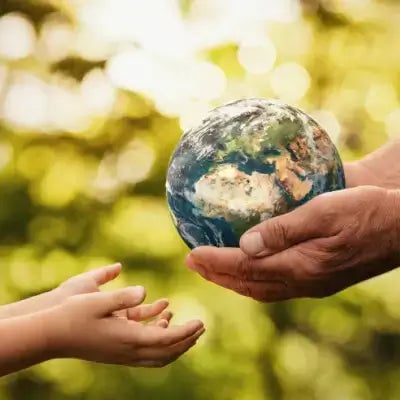Across the country (and the world), local habitats are being rapidly destroyed by natural and artificial causes
Many locations spend money on creating artificial structures and solutions to mitigate the problem. But many people don't realize that one of the simplest and most effective ecological restoration methods lies in the backyard. Native plants vary by region and are an excellent solution to habitat damage. Native plants are specially adapted to living in specific environments. When used as an ecological restoration tool, they can make the soils in the area more robust, repopulate hillsides and floodplains, and even help restore local wildlife populations.
Benefits of Native Plants
From weakened soil to plant diseases, non-native species and manufactured causes like agricultural production and over-development can jeopardize a local environment. Add to the problem regionally-specific concerns like water shortage, fire, shoreline erosion, and ecological devastation seems insurmountable! One of the biggest problems across the United States is excessive water consumption, leading to water loss. Modern landscaping alone accounts for about a third of all residential water usage. This includes watering gardens and potted plants filled with non-native species not adapted to the local climate. But by switching to native plants, you can reduce landscaping water consumption by up to 75%. This is important everywhere, but it is especially vital in dry, arid desert regions where water is a scarce commodity.
Another way ecological restoration plants benefit the environment is by using fewer pesticides. Pesticides and fertilizers are used individually and commercially to facilitate plant growth. This is especially true in areas where non-native plants have been introduced and need external aid to grow in their local conditions. By planting native plants, trees, and grasses, however, you can significantly reduce the number of pesticides needed. Planting ferns in forested areas and prairie grasses on open fields, for instance, re-introduces native species. Since they already thrive in the local conditions, they don't need your assistance to grow.
Preserve the Natural Landscape
While it might initially be neat to see tropical plants growing in your garden during summer, the reality is that introduced species can (and often do) cause more harm than good. When introducing foreign species, you are setting yourself up for higher-maintenance plant care, as your plantings generally can't grow without help in their introduced environment. Furthermore, non-native species are more likely to introduce diseases and insects that can harm local vegetation. Planting steep slopes with shallow-rooted plants can be disastrous, as slopes need the deep roots of species like serviceberry, willow trees, and ferns to resist erosion. Additionally, non-native plants will likely not survive harsher environmental conditions, such as long winters, which means you waste time, energy, and resources.
Through natural disasters, human activities, or a combination of both, sensitive environments are prone to degradation. Restoring them can be costly and time-consuming, but using native plants can help. Native plants are hardy and resilient, one of the best choices for making a quick, permanent fix to get your local environment back to good health.
Revitalizing Our Planet on a Budget
Ecological restoration can be achieved without significant funding through government agencies or big institutions. People of all financial means can meaningfully help restore and protect our environment through individual actions. Communities worldwide can create significant change by implementing small yet powerful environmental actions together. The following methods offer affordable solutions to restore ecological health while ensuring a sustainable planet for future generations.
The most inexpensive and basic method to restore the environment involves planting native plant species. Because native plants have adapted to the local conditions, they need less maintenance and resources than non-native plants. When you plant native trees, shrubs, and flowers within a section of your yard, you provide essential support to vital pollinators and additional wildlife. You can usually gather seeds from friends and neighbors or nearby public gardens as an alternative to buying costly seedlings.
Composting provides an economical method to transform kitchen leftovers and yard debris into rich soil nutrients. Build a compost bin from old pallets or wire mesh, or use an existing plastic container to stop organic waste from reaching landfills while producing free garden fertilizer. By using compost to create natural fertilizer, we lessen dependency on chemical fertilizers that harm waterways while boosting soil quality to foster more vigorous plant and tree growth.
Organizing cleanup activities in local waterways and green spaces delivers positive environmental impacts with minimal financial investment. Participating in or leading a neighborhood cleanup contributes to eliminating trash, plastic waste, and other harmful substances from ecological areas. These initiatives protect ecosystems from pollution damage while safeguarding wildlife from potential threats. Teamwork enables you to address stream banks, beaches, park trails, and other shared spaces. To conduct cleanups, you need essential equipment, gloves, trash bags, and the willingness to participate actively. Beautifying local spaces through collective hands-on work leads to additional community pride.
Water conservation efforts deliver substantial ecological advantages without causing significant financial strain. Using affordable rain barrels to gather water for garden and lawn irrigation decreases pressure on community water systems. Installing low-flow showerheads, repairing plumbing leaks, and watering plants early in the morning or late at night represent straightforward methods that support sustainable living while saving money. When we save water, it reduces pressure on river systems and groundwater sources, which helps preserve aquatic habitats.
You can easily support biodiversity in your yard or balcony without spending much money. Create bird feeders and insect habitats from recycled materials like old wood pieces and bamboo or plastic bottles. Local wildlife benefits greatly from minimal water sources like shallow dishes or bird baths. Supporting bee and butterfly populations leads to healthier ecosystems because these insects play a crucial role in plant reproduction.
Achieving lasting ecological restoration requires robust education programs and active community participation. When you share tips with friends, join free workshops, and organize local events, you boost the power of these budget-friendly methods. Small-scale restoration projects led by educated citizens create a powerful environmental movement when combined.
Environmental restoration need not involve high expenses. The planet can be rejuvenated through community efforts that practice native species planting, composting, and cleanups while saving water resources and promoting biodiversity. This allows for awareness campaigns to happen, all in a cost-effective manner.
Read more

When ecosystems and habitats become damaged, degraded, or otherwise destroyed, they need assistance returning to total health. One of the most sustainable methods used in habitat restoration involv...

Trees: No landscaping plan is complete without trees. If your lot already has plenty, great. But if there are only a few or, worse yet, none at all, few things will improve a landscape as much as a...


